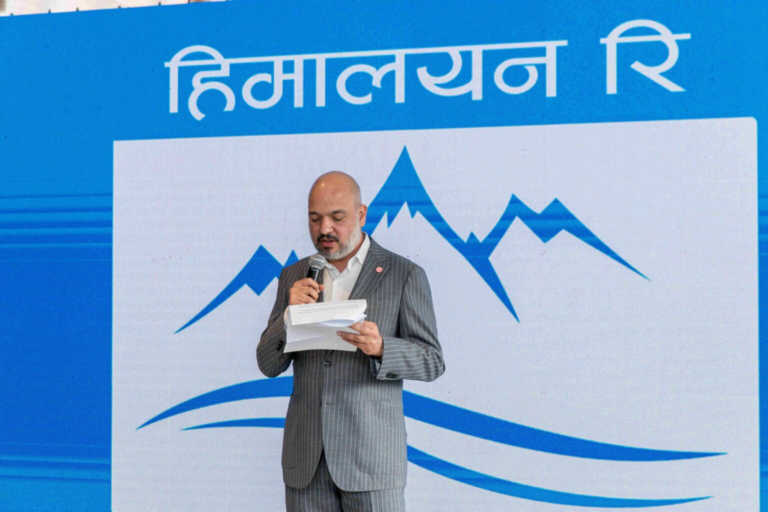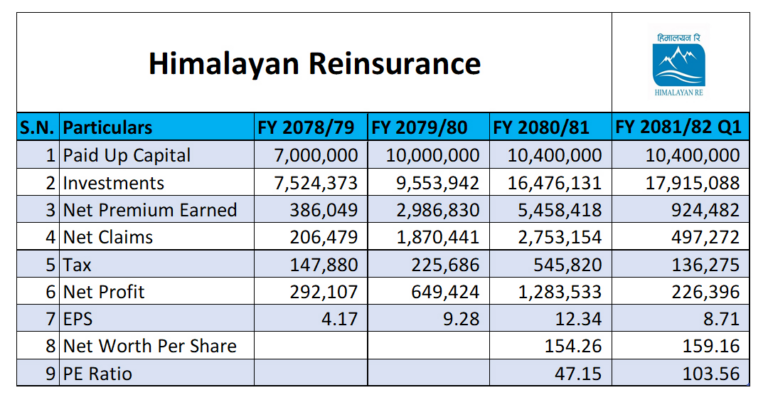Kathmandu: Himalayan Reinsurance, Nepal’s only private-sector reinsurance company, has rapidly grown into a significant and robust entity within just three years of establishment. Along with achieving operational efficiency, the company has seen a notable boost in productivity, setting new milestones in business expansion despite its relatively short experience.

The issuance of an IPO to the public has strengthened the company’s liquidity profile and capitalization. Additionally, regulatory support has facilitated Himalayan Re’s business expansion, with the Nepal Insurance Authority ensuring a portion of both premiums and risks in the domestic reinsurance market.
While the company continues to rely on the domestic insurance market, its growth in foreign reinsurance markets has been impressive. The approval from the Indian insurance regulator for cross-border reinsurance has further propelled its journey. Within its first year of entering the Indian market, Himalayan Re secured a treaty partnership with the globally renowned GIC Re, marking a significant achievement.
The company’s confidence was further solidified when it received a B+ rating from the globally reputed rating agency A.M. Best. Today, Himalayan Re has expanded its operations to approximately 36 countries, including India, solidifying its international presence.

Financial Performance and Stability
Himalayan Re has maintained strong financial health, demonstrated by a sufficient solvency ratio and quality term deposits in FY 2080/81 (2023/24). With majority private ownership and investment from two major government-owned commercial banks—Nepal Bank and Rastriya Banijya Bank—the company enjoys a robust financial foundation.
Under the leadership of Shekhar Golchha, a former president of the Federation of Nepalese Chambers of Commerce and Industry (FNCCI), and CEO Upasana Paudel, who is Nepal’s youngest and only female CEO in the insurance sector, the company’s management team has gained trust and momentum. Their strategic vision and experienced team have been instrumental in the company’s success.
Regulatory Support and Market Dynamics
The Nepal Insurance Authority mandates domestic insurance companies to allocate 20% of direct insurance and 30% of treaty reinsurance business to local reinsurance companies. This regulatory cushion has helped Himalayan Re establish its footing, though the gradual reduction of the direct session mandate (2% per year) may impact underwriting profits in the future.
Despite this, Himalayan Re reported a net profit of NPR 1.28 billion in the previous fiscal year, achieving an EPS of NPR 12.34 and a net worth per share of NPR 154.26. For the first quarter of FY 2080/81, the company generated a net premium of NPR 930 million and a profit of approximately NPR 230 million, reflecting its steady financial growth.
Operational Efficiency
Himalayan Re’s efficiency is reflected in its low management expense ratio, which stands at 12% of net premium earned, and a commission expense of just 25%. This highlights effective cost management and productivity.
Future Outlook
However, the company faces potential risks from its retrocession strategy. While moderate retrocession coverage helps mitigate losses, overly aggressive strategies could pose challenges to profits and solvency during large-scale disasters. The experienced management team, with expertise in Nepal and India, will be pivotal in navigating these complexities.
As Himalayan Re continues its journey, its focus on efficiency, regulatory compliance, and market expansion positions it as a key player in Nepal’s reinsurance sector and beyond.



 About Us
About Us
Comment